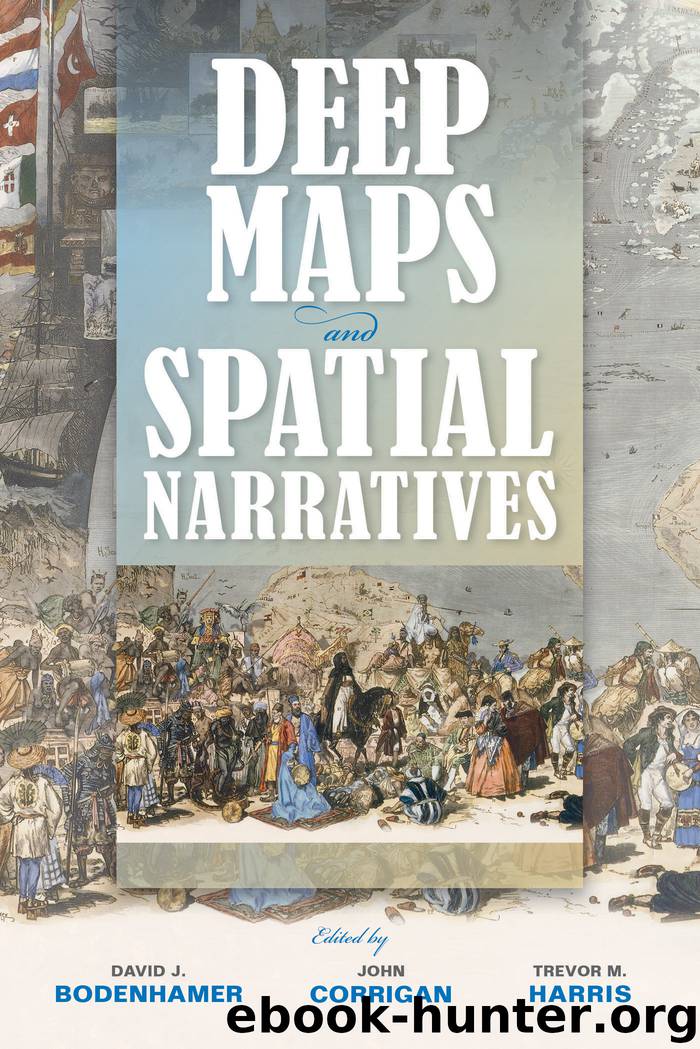Deep Maps and Spatial Narratives by David J. Bodenhamer John Corrigan Trevor M. Harris & John Corrigan & Trevor M. Harris

Author:David J. Bodenhamer,John Corrigan,Trevor M. Harris & John Corrigan & Trevor M. Harris
Language: eng
Format: epub
Publisher: Indiana University Press
Published: 2015-03-17T16:00:00+00:00
FATHERING FINDING FORM: AN EXAMPLE OF TENDER MAPPING
The coproduction of bodies, memories, emotions, and space matter. For a number of years now, I have been asking questions regarding men’s resistance to and culpability with hegemonic norms of fatherhood.33 How, precisely, do men struggle against formative notions of an imperious and patriarchal norm that prescribes the “law of the father”? What spaces facilitate this? The example I have chosen to elaborate an ethnopoetics of space, comes from an ethnographic project with fathers that spans fifteen years. During that time, I got to know Rex and his story as a father. When I met him, he was in his late forties with two estranged sons, Manny and Simon. For a large part of his life, Rex was a “line man” for San Diego Gas and Electric, working on telephone poles and power lines. After successfully battling substance abuse, Rex earned a master’s degree in social work. One of Rex’s passions was reading and he particularly enjoyed debate on issues of social and labor justice. Over the years I knew him, his relations with his sons improved and, as they did so, his passions turned to his two boys and his grandson. Appendix A is an elaboration of a transcribed interview that I conducted with Rex in 2008, two years before he died.34
The boxed dialogue and discussion (Appendix A) is part of a larger three-hour interview in which Rex took time to think through his fathering story. The story is partitioned chronologically through a series of moves from one house to another, from a beach community to a mountainous interior community and then back to a neighborhood close to San Diego State University: seven moves in all. To this extent, Rex’s story is about movement, relocation, and the search for a place for his fathering that is not an imperious connection with his boys. That said, there is still the continued need for connection through control. The rural idyll does not work because, for Rex, that geographic solution is not one about which he has control. His continued moves to find a better place to raise Manny after Simon and his first wife Molly left certainly reflect his commitment as a father, but it is the emotional trauma brought on by his son’s threat of leaving that refracts the loss of Simon years before and highlights for Rex what is truly important. And it is the beginning of his move away from trying to control the people around him. The pain of the possibility of losing Manny to his continued abuse of alcohol was too much for Rex, and so he was pushed to find a solution that was not about geographic change but inner change. This was the crux of fathering for Rex and the emotional precipice (perhaps a mise-en-abyme) upon which his whole sense of self teetered. Figure 5.2 reflects Rex’s physical movement through Cartesian space by unlabeled arrows. The other arrows represent the departure of Molly to Ramona, Simon to Nebraska, and Manny to Los Angeles.
Download
This site does not store any files on its server. We only index and link to content provided by other sites. Please contact the content providers to delete copyright contents if any and email us, we'll remove relevant links or contents immediately.
Cecilia; Or, Memoirs of an Heiress — Volume 1 by Fanny Burney(32503)
Cecilia; Or, Memoirs of an Heiress — Volume 2 by Fanny Burney(31913)
Cecilia; Or, Memoirs of an Heiress — Volume 3 by Fanny Burney(31898)
The Great Music City by Andrea Baker(31759)
We're Going to Need More Wine by Gabrielle Union(19004)
All the Missing Girls by Megan Miranda(15784)
Pimp by Iceberg Slim(14438)
Bombshells: Glamour Girls of a Lifetime by Sullivan Steve(14024)
For the Love of Europe by Rick Steves(13627)
Talking to Strangers by Malcolm Gladwell(13297)
Norse Mythology by Gaiman Neil(13281)
Fifty Shades Freed by E L James(13189)
Mindhunter: Inside the FBI's Elite Serial Crime Unit by John E. Douglas & Mark Olshaker(9266)
Crazy Rich Asians by Kevin Kwan(9224)
The Lost Art of Listening by Michael P. Nichols(7456)
Enlightenment Now: The Case for Reason, Science, Humanism, and Progress by Steven Pinker(7274)
The Four Agreements by Don Miguel Ruiz(6704)
Bad Blood by John Carreyrou(6584)
Weapons of Math Destruction by Cathy O'Neil(6220)
